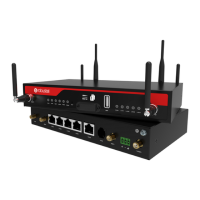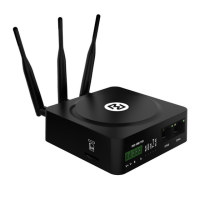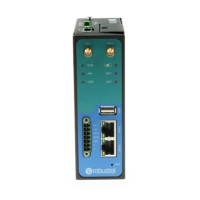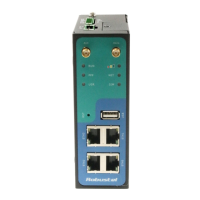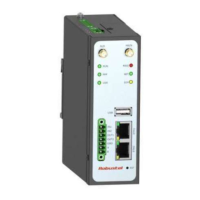



Do you have a question about the Robustel R2000 and is the answer not in the manual?
| Model | R2000 |
|---|---|
| Category | Network Router |
| Cellular Connectivity | 4G LTE |
| WAN Ports | 1 |
| Ethernet Ports | 2 |
| Input Voltage | 9-36 VDC |
| SIM Slots | 2 |
| Certifications | CE, FCC, RoHS |
| Operating Temperature | -40°C to 75°C |
Provides hardware and software information, including introduction, installation, configuration, and operation.
Contact details for technical assistance, including phone, fax, email, and web.
Covers RF safety, usage restrictions, interference, antenna connection, and safe distance.
Details FCC RF radiation exposure limits and co-location restrictions for the device.
Provides guidelines for installing and using the router safely within a vehicle.
Advises on careful installation and operation to ensure error-free usage and maintain warranty.
Lists relevant directives and standards for product approval and compliance.
Lists updates and changes made to document versions, including dates and descriptions.
Lists the main features of the Robustel R2000 Industrial Dual SIM Cellular VPN Router.
Lists the items included in the R2000 router package for verification.
Details cellular standards, frequency bands, and data speeds for the router.
Details Ethernet port count, speed, and isolation protection.
Details WiFi standards, frequency bands, security, and data speed.
Provides detailed physical dimensions of the R2000 router.
Lists different model variants and their specifications for ordering purposes.
Details the pin assignments for the power connector on the router.
Explains the meaning and status of the various LED indicators on the router.
Describes how to perform a router reboot or restore factory default settings using the reset button.
Describes the two Ethernet ports (ETH0, ETH1) and their link indicators.
Provides step-by-step instructions for inserting and removing SIM cards from the router.
Instructions on connecting external SMA antennas to the router's connectors.
Explains methods for mounting the router, including wall and DIN rail options with screw specs.
Explains the importance of grounding the router for electromagnetic interference prevention.
Guide to connect the router to a computer via Ethernet for initial access.
Details on connecting the power adapter, voltage specifications, and polarity.
Explains how to power the router via Power over Ethernet (PoE) connection.
Guides on setting the PC's IP address for router connection and access.
Lists default username, password, and IP addresses for router access.
Step-by-step guide to access and log in to the router's web interface.
Describes the web interface's main functions like Save, Reboot, and Logout.
Explains how to view system, internet, and LAN status information.
Allows setup of primary/backup WAN/WLAN links and backup modes.
Setting up the router as a WiFi Access Point with various security options.
Configuration of LAN ports, IP addresses, Netmask, and DHCP server settings.
Configuration of physical Ethernet ports (ETH0, ETH1) as WAN or LAN.
Settings for SIM cards, network type, band selection, and cellular status.
Connecting the router to an existing WiFi network as a client.
Configuration of static routes for network traffic management.
Setting up firewall rules and traffic filtering for security.
Configuring port forwarding rules for external access to internal services.
Configuration for the Demilitarized Zone (DMZ) host.
General settings for IPsec VPN, including NAT Traversal and Debug.
Configuration for OpenVPN tunnels, supporting Client and P2P modes.
Setup for Generic Routing Encapsulation (GRE) tunnels.
Configuration for saving and sending system logs to a remote server.
Configuration for event parameters and sending alerts via SMS or Email.
Configuration for Network Time Protocol (NTP) client settings.
Configuration for SMS management and sending commands via SMS.
Configuration for sending event notifications via Email.
Configuration for Dynamic DNS (DDNS) to alias a dynamic IP to a static domain name.
Configuring secure shell (SSH) access, including password and key-based authentication.
Configuring HTTP/HTTPS ports and importing certificates for the web server.
Advanced system configurations like device name and User LED type.
Accessing syslog details and generating system diagnostic data.
Procedure for upgrading the router's firmware.
Using the Ping tool to test network reachability and latency.
Using the Traceroute tool to trace the route to a destination IP address.
Using the Sniffer tool for network packet capture and traffic analysis.
Importing/exporting configurations and restoring router to factory defaults.
Managing user accounts, including super user and common users with different roles.
Practical steps for configuring primary and backup SIM cards for cellular dial-up.
Using SMS for router control and configuration with authentication types.
Practical setup examples for IPsec VPN server and client configurations.
Practical setup example for OpenVPN client configurations.
Practical setup examples for GRE VPN tunnels.
Basic overview of Command Line Interface (CLI) and router login procedures.
Tips, error handling, and examples for configuring the router via CLI.
A reference list of commands for Debug, Show, Set, and Add functions.
